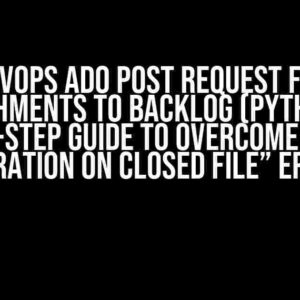Are you tired of encountering issues with AEM publishers crashing while deploying your Angular 13 application in Jenkins? You’re not alone! This frustrating error can bring your development process to a grinding halt. But fear not, dear developer, for we’ve got you covered. In this comprehensive guide, we’ll walk you through the steps to resolve this issue and get your deployment up and running smoothly.
Understanding the Problem
Before we dive into the solution, let’s take a step back and understand why this issue occurs in the first place. When you deploy your Angular 13 application in Jenkins, the platform team’s AEM publishers are responsible for rendering the content. However, during this process, the publishers may crash due to incompatible versions of Angular and AEM.
This incompatibility can arise from various factors, including:
- Outdated AEM publishers that are not compatible with Angular 13
- Incorrect configuration of the AEM publishers in Jenkins
- Missing dependencies or libraries required for Angular 13
- Version conflicts between Angular 13 and other dependencies in the project
Step 1: Update AEM Publishers
The first step in resolving this issue is to update the AEM publishers to a version that is compatible with Angular 13. To do this, follow these steps:
- Log in to your AEM instance and navigate to the
http://localhost:4502 시스템/console/bundlespage. - Search for the “Adobe AEM Publisher” bundle and click on it.
- Click on the “Update” button to update the bundle to the latest version.
- Restart the AEM instance to ensure the changes take effect.
Step 2: Configure AEM Publishers in Jenkins
Once the AEM publishers are updated, you need to configure them correctly in Jenkins. To do this, follow these steps:
- Log in to your Jenkins instance and navigate to the job configuration page.
- Scroll down to the “Post-build Actions” section and click on the “Add post-build action” button.
- Select “Publish to Adobe AEM” and configure the AEM publisher settings as required.
- Make sure to select the correct AEM instance and publisher configuration.
- Save the changes and restart the Jenkins job.
Step 3: Install Required Dependencies
Angular 13 requires certain dependencies to function correctly. To ensure that these dependencies are installed, follow these steps:
- Open your project’s
package.jsonfile and add the following dependencies:
"dependencies": {
"@angular/core": "^13.0.0",
"@angular/common": "^13.0.0",
"@angular/compiler": "^13.0.0",
"@angular/platform-browser": "^13.0.0",
"@angular/platform-browser-dynamic": "^13.0.0",
"rxjs": "^7.5.0",
"zone.js": "^0.11.4"
}
- Run the command
npm installto install the dependencies. - Verify that the dependencies are installed correctly by running the command
npm ls.
Step 4: Resolve Version Conflicts
Version conflicts can arise when different dependencies in your project have different version requirements. To resolve these conflicts, follow these steps:
- Use a tool like
npm auditto identify any version conflicts in your project. - Analyze the conflicts and determine the correct version of each dependency.
- Update the
package.jsonfile to reflect the correct versions. - Run the command
npm installto install the dependencies with the correct versions.
Step 5: Verify the Solution
Once you’ve completed the above steps, it’s time to verify that the solution works. To do this, follow these steps:
- Deploy your Angular 13 application in Jenkins.
- Verify that the AEM publishers are running correctly and not crashing.
- Test your application to ensure that it’s functioning as expected.
| Step | Action | Result |
|---|---|---|
| 1 | Update AEM publishers | AEM publishers are updated to a version compatible with Angular 13 |
| 2 | Configure AEM publishers in Jenkins | AEM publishers are configured correctly in Jenkins |
| 3 | Install required dependencies | Required dependencies are installed correctly |
| 4 | Resolve version conflicts | Version conflicts are resolved, and dependencies are installed with correct versions |
| 5 | Verify the solution | AEM publishers are running correctly, and the application is functioning as expected |
By following these steps, you should be able to resolve the issue of AEM publishers crashing while deploying your Angular 13 application in Jenkins. Remember to stay calm and patient, and don’t hesitate to reach out if you encounter any further issues.
Conclusion
Deploying an Angular 13 application in Jenkins can be a complex process, but by following the steps outlined in this guide, you can overcome the hurdle of AEM publishers crashing. Remember to keep your AEM publishers up to date, configure them correctly in Jenkins, install required dependencies, resolve version conflicts, and verify the solution. With these steps, you’ll be well on your way to a successful deployment.
Happy coding, and don’t forget to share your experiences in the comments below!
Frequently Asked Question
Are you tired of dealing with AEM publishers crashing while deploying Angular 13 in Jenkins? Don’t worry, we’ve got you covered! Here are some frequently asked questions to help you troubleshoot and resolve the issue.
What is the primary cause of AEM publishers crashing during Angular 13 deployment in Jenkins?
The primary cause of AEM publishers crashing is usually due to incompatible Angular versions or incorrect configuration. Ensure that your Angular version is compatible with AEM and Jenkins, and review your configuration files to resolve any conflicts.
How do I troubleshoot the AEM publishers crashing issue in Jenkins?
To troubleshoot the issue, review the Jenkins console logs for error messages, check the AEM publisher logs for any configuration issues, and verify that the Angular application is building correctly. Also, try deploying the application manually outside of Jenkins to isolate the problem.
What are the common Angular configuration mistakes that can cause AEM publishers to crash?
Common mistakes include incorrect or outdated dependencies, incorrect module imports, and incorrect environment variables. Review your Angular configuration files, such as angular.json, package.json, and environment files, to ensure they are correct and up-to-date.
How do I optimize my Angular application for deployment in AEM?
Optimize your Angular application by ensuring proper code splitting, optimizing images, minifying code, and configuring lazy loading. Also, review AEM’s official documentation for best practices on deploying Angular applications in AEM.
What are the benefits of using a compatibility matrix to resolve AEM publishers crashing issues?
A compatibility matrix helps ensure that all dependencies, including Angular, AEM, and Jenkins, are compatible with each other. This reduces the chances of conflicts and crashes, making it easier to identify and resolve issues.



